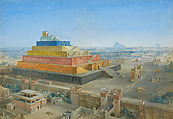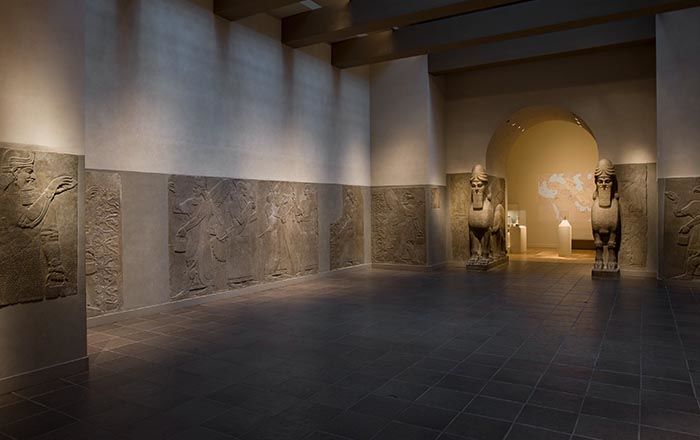The Tower of Babel or Birs Nimrud Restored
William Simpson British, Scottish
Not on view
This watercolor is a vivid nineteenth-century reconstruction of a Babylonian city. Even though he worked before the major excavations at Babylon in southern Iraq, which began in 1899, Simpson inventively combined information from recent excavations of Assyrian palaces in northern Iraq, ancient Greek accounts of the city of Babylon, and contemporary European travel accounts describing the landscape and ancient ruins visible around the site.
Throughout the nineteenth century, European antiquarians remained uncertain of the location of ancient Babylon. Even though locally the name Babil was still attached to part of the correct site, other locations, some quite distant, were suggested. This produced multiple possible candidates for the biblical Tower of Babel or the Temple of Zeus-Belus described by Herodotus. Simpson here relies on the vast dimensions for ancient Babylon given by Herodotus and other ancient authors, together with the high surviving ruins of a ziggurat (Mesopotamian temple-tower) at Birs Nimrud, concluding that structure must have influenced biblical and Greek accounts. We now know Birs Nimrud to have been another city, known in ancient times as Borsippa and located a few miles from Babylon. Even though enormous by ancient standards, it falls short of the dimensions given in ancient Greek accounts. The remains of that city’s ziggurat did, however, enable Simpson to imaginatively construct, in his watercolor, a stepped tower with stairways set within a huge open courtyard. Other distant ziggurats allow us to understand how these artificial mountains once served as visual punctuation points on the flat alluvial plain of southern Iraq. The bright colors and stair structures in the drawing are less plausible, although the shrine built on top of the ziggurat may well have been covered in blue glazed bricks. Simpson’s primary source for the latter would again have been Herodotus, who describes some version of a ‘sacred marriage’ ritual taking place there. Even today, with many more Babylonian texts to consult, we do not know exactly what rituals were performed atop the ziggurat; possibly because that information was always highly restricted. The city walls and the gate in front foreground here are based on Assyrian models. Interestingly, later excavations at Babylon would uncover closely related architectural forms.
This image cannot be enlarged, viewed at full screen, or downloaded.

